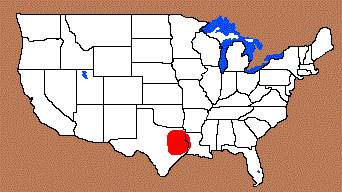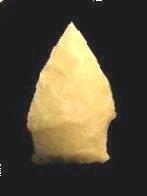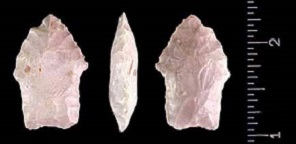Outline is Representative of Size and Shape:

Name Details:
Identified By: William W. Cook and R. K. Harris
Named For:
Date Identified: 1952
Type Site:
Identified By: William W. Cook and R. K. Harris
Named For:
Date Identified: 1952
Type Site:
Point Validity:
Valid type
Crook is an avocational archaeologist from Texas who has conducted extensive investigations along the Trinity River in Texas. Harris is a pioneer in Texas archaeology and has publishing many professional books. This type was named in a professional publication and has many professional references. This is considered a valid type.
Crook is an avocational archaeologist from Texas who has conducted extensive investigations along the Trinity River in Texas. Harris is a pioneer in Texas archaeology and has publishing many professional books. This type was named in a professional publication and has many professional references. This is considered a valid type.
Elam Stemmed
Cluster: Description of Physical Characteristics and Flaking Pattern:
This is a small stubby triangular stemmed point with an elliptical cross section. The blade is primarily straight, but may vary to excurvate. The shoulders are weakly developed to absent and at an upward angle. The stem is straight to slightly expanding and makes up one half to one third of the point. The base varies from straight to convex. This point commonly has smoothing of the stem edges, but not the basal edge and has a random flaking pattern.
Size Measurements:
Length - 20 to 36 mm, Stem Length - 10 to 18 mm (typically making up 1/2 or more of the total length), Width - 25 to 30 mm
Length - 20 to 36 mm, Stem Length - 10 to 18 mm (typically making up 1/2 or more of the total length), Width - 25 to 30 mm
Commonly Utilized Material:
Additional Comments:
Suhm and Krieger (1954) questioned if Dallas points were distinct enough from Elam points to warrant Dallas Stemmed to be considered a separate type. They looked at examples from the University of Texas and noted that the characteristics of the Dallas type overlapped Elam points. There were no distinguishing characteristics noted between the two types. The only distinction seems to be the distribution.
Suhm and Krieger (1954) questioned if Dallas points were distinct enough from Elam points to warrant Dallas Stemmed to be considered a separate type. They looked at examples from the University of Texas and noted that the characteristics of the Dallas type overlapped Elam points. There were no distinguishing characteristics noted between the two types. The only distinction seems to be the distribution.
Distribution:
Distribution Comments:
This point is primarily found in the East Fork and Trinity River valleys and have reduced frequency in other highlighted regions.
This point is primarily found in the East Fork and Trinity River valleys and have reduced frequency in other highlighted regions.
Age / Periods:
Date: 3,000 - 2,000 B.P.
Cultural Period: Late to Transitional Archaic
Glacial Period: Neoglacial to Roman Warm
Culture:
Date: 3,000 - 2,000 B.P.
Cultural Period: Late to Transitional Archaic
Glacial Period: Neoglacial to Roman Warm
Culture:
Age Details:
Other points in this cluster / Related / Associated Points:


